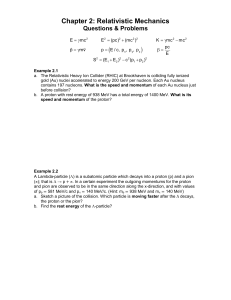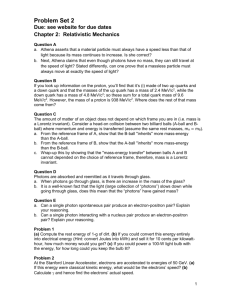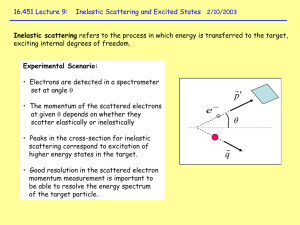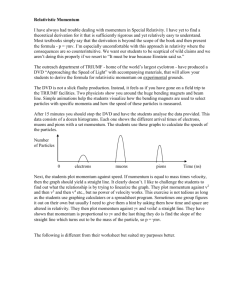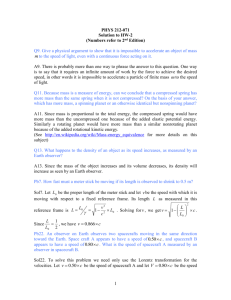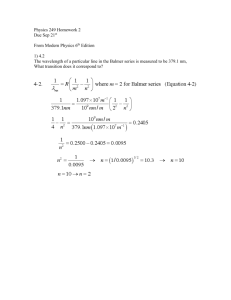MPTC_Zmass
advertisement
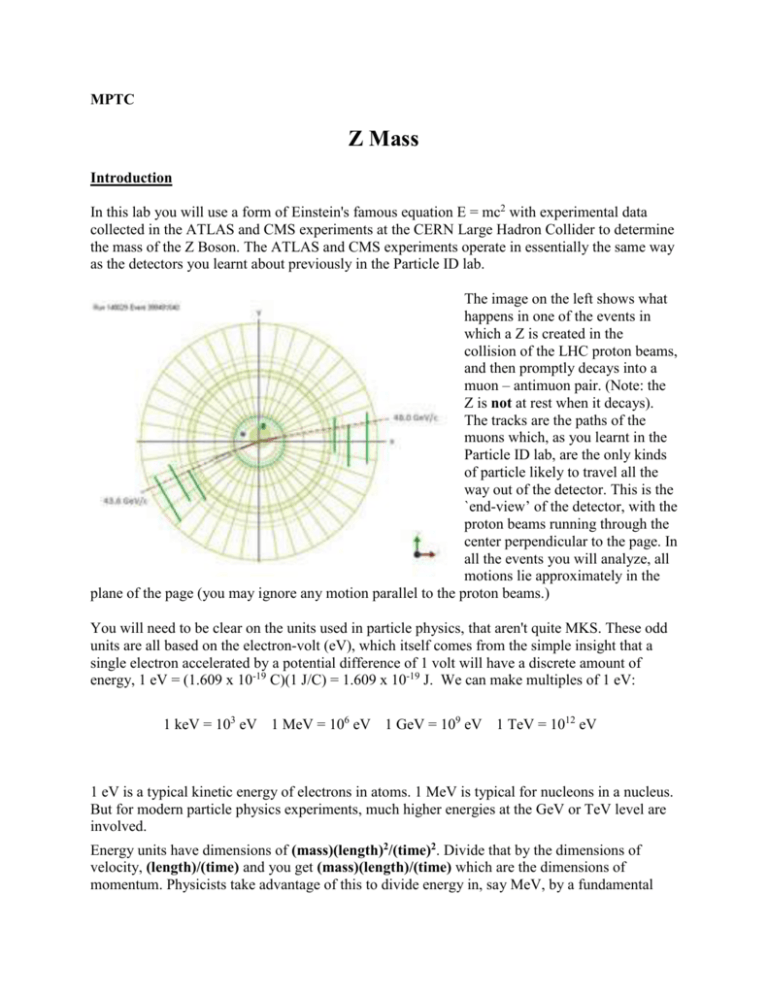
MPTC Z Mass Introduction In this lab you will use a form of Einstein's famous equation E = mc2 with experimental data collected in the ATLAS and CMS experiments at the CERN Large Hadron Collider to determine the mass of the Z Boson. The ATLAS and CMS experiments operate in essentially the same way as the detectors you learnt about previously in the Particle ID lab. The image on the left shows what happens in one of the events in which a Z is created in the collision of the LHC proton beams, and then promptly decays into a muon – antimuon pair. (Note: the Z is not at rest when it decays). The tracks are the paths of the muons which, as you learnt in the Particle ID lab, are the only kinds of particle likely to travel all the way out of the detector. This is the `end-view’ of the detector, with the proton beams running through the center perpendicular to the page. In all the events you will analyze, all motions lie approximately in the plane of the page (you may ignore any motion parallel to the proton beams.) You will need to be clear on the units used in particle physics, that aren't quite MKS. These odd units are all based on the electron-volt (eV), which itself comes from the simple insight that a single electron accelerated by a potential difference of 1 volt will have a discrete amount of energy, 1 eV = (1.609 x 10-19 C)(1 J/C) = 1.609 x 10-19 J. We can make multiples of 1 eV: 1 keV = 103 eV 1 MeV = 106 eV 1 GeV = 109 eV 1 TeV = 1012 eV 1 eV is a typical kinetic energy of electrons in atoms. 1 MeV is typical for nucleons in a nucleus. But for modern particle physics experiments, much higher energies at the GeV or TeV level are involved. Energy units have dimensions of (mass)(length)2/(time)2. Divide that by the dimensions of velocity, (length)/(time) and you get (mass)(length)/(time) which are the dimensions of momentum. Physicists take advantage of this to divide energy in, say MeV, by a fundamental constant that has units of velocity, namely the speed of light c, to get useful units of momentum: MeV/c. Anytime we divide energy units by c we get momentum: eV/c, keV/c, MeV/c, GeV/c and even TeV/c. If we divide by c again, then we are dividing (length)/(time) out of our momentum dimensions, leaving only (mass). Thus, physicists make mass units out of eV/c2, keV/c2, MeV/c2, GeV/c2 and, TeV/c2. So if mass units equal energy units divided by c2, instead of writing E = mc2, we could just say E = m. So in effect we are setting c = 1 in all our formulas (redefining the unit of length and/or time). Of course, you know that in any language endings get dropped. Going to becomes gonna, buenos dias becomes buen' dia, etc. So physicists will often refer to the energy of a particle in MeV, its momentum in MeV, and its mass in MeV. They should say MeV, MeV/c, and MeV/c2, respectively. Here are the conversion factors back to MKS units ENERGY MOMENTUM MASS 1 eV = 1.609 x 10-19 J 1 eV/c = 5.36 x 10-28 kg-m/s 1 eV/c2 = 1.79 x 10-36 kg Practice these conversions: 1. A proton in the Fermilab Tevatron has an energy of 1.00 TeV. What is this energy in Joules? 2. A 2.00 g bug moves at 0.100 cm/s. Find its momentum in MeV/c. 3. The mass of a proton is 1.67 x 10-27 kg. Convert this to GeV/c2 Equipment Protractor. (And Ruler and pencil if using printouts of events). Procedure Pick either the 4 CMS events or the 4 Atlas events shown here: http://leptoquark.hep.nd.edu/~kcecire/zweb/data.html Using the protractor to measure and any data given on the event display itself, fill in the cells of a table like the one below for each event that you analyze. (Muon 1 and muon 2 refer to the two tracks.) Leave blank for the moment any cell values that are not directly measured. Experiment:__________ Event No:____________ Muon 1 Muon 2 Z Energy Angle (to positive x - axis) Leave blank Momentum Momentum x-component Momentum y-component Mass Assume 0 Assume 0 Analysis To complete the cells with results that require calculation (rather than measurement) you will need to use the following: Momentum and Energy are both conserved. Momentum is a vector. Energy is a scalar. Muons have such a small mass compared to their energy in these events, we neglect it. The relationship between energy E, momentum p, and mass m of a particle in special relativity is (in units where c=1) E2 = p2 + m2 1. Complete the table cells requiring calculation, showing a sample calculation for one of the events. 2. Average your results for the Z mass and quote your final result with an uncertainty. 3. Write your result on the board so it can be compared to that obtained by other groups. 4. To what extent can results from different groups be combined?
